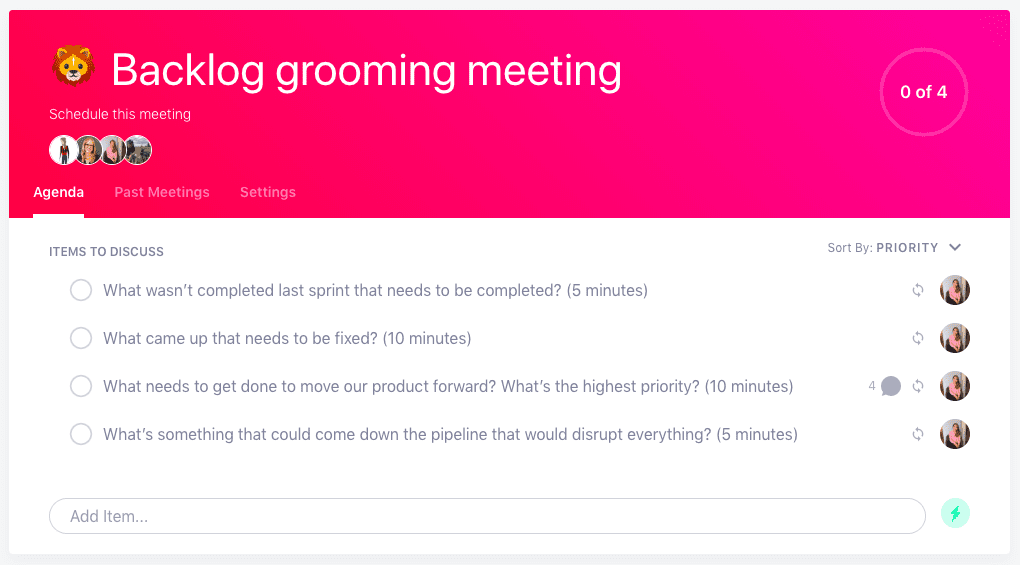The 30-minute backlog grooming meeting agenda
A backlog grooming meeting, or a “grooming scrum” is a scrum ceremony and part of the agile meeting process. Backlog…
Warning: Undefined array key "category" in /www/hypercontext_216/public/wp-content/themes/Soapbox/hype-files/sections/article/content.php on line 10
A backlog grooming meeting, or a “grooming scrum” is a scrum ceremony and part of the agile meeting process. Backlog grooming meetings are typically held toward the end of a sprint. The goal of the meeting is to keep your backlog (the complete list of projects that remain to be done) up-to-date and ready to be pulled from for upcoming sprints.
Frequency: Sprintly (bi-weekly)
Meeting length: 30 minutes
Here are four items to include on your backlog grooming meeting agenda:
Click here to jump to the Hypercontext backlog grooming meeting agenda template!
1. What wasn’t completed last sprint that needs to be completed? (5 minutes)
Hopefully this list is small – and you should already be well-informed coming into this meeting as to what wasn’t done and why. During this discussion, determine whether or not the estimates were accurate for the project, and if the uncompleted work can move into the next sprint.
2. What came up that needs to be fixed? (10 minutes)
As you’re continuously building and refining a product, you’ll inevitably run into bugs or larger problems with your journey. Determine the scope of work and prioritize those projects in this meeting.
3. What needs to get done to move our product forward? What’s the highest priority? (10 minutes)
Beyond fixes and work carrying over from past sprints (and hopefully these don’t monopolize the work for the upcoming sprint – though at times they will), go through the product backlog. Often times this means new features, new functionalities, etc.
4. What’s something that could come down the pipeline that would disrupt everything? (5 minutes)
Reserve a few minutes at the end of your grooming scrum to ask your team if there’s anything that will inhibit tackling high-priority projects and tasks off your backlog.
Other backlog grooming meeting tips
Manage your projects in real time
Keep your project management tool (we use Jira) open while you’re running this meeting. Use it to look at new bugs, issues and technical debt to help facilitate the meeting.
Order your backlog by priority (and group by sprints)
If a project doesn’t have story points attached to it but is in the backlog, then it shouldn’t be at the top of the list. The idea here is that if something takes high priority, it should have story points attached to it in order to move forward.
Keep a record of your backlog meetings
Like any meeting, make sure you take notes and assign action items as they come up in your meeting. That way, anyone can revisit what was discussed and the context of the backlog.
Keeping your backlog up-to-date is important for any product and development team. It ensures you’re tackling the right things and allocating the right amounts of time for your team.
Your Hypercontext backlog grooming meeting agenda template 👇
Use this backlog grooming agenda in Hypercontext
What to do now
Now that you've read this article, here are some things you should do:
- You should check out our massive (& free) collection of meeting agenda templates to help you run more effective meetings.
- Check out Spinach to see how it can help you run a high performing org.
- If you found this article helpful, please share it with others on Linkedin or X (Twitter)

